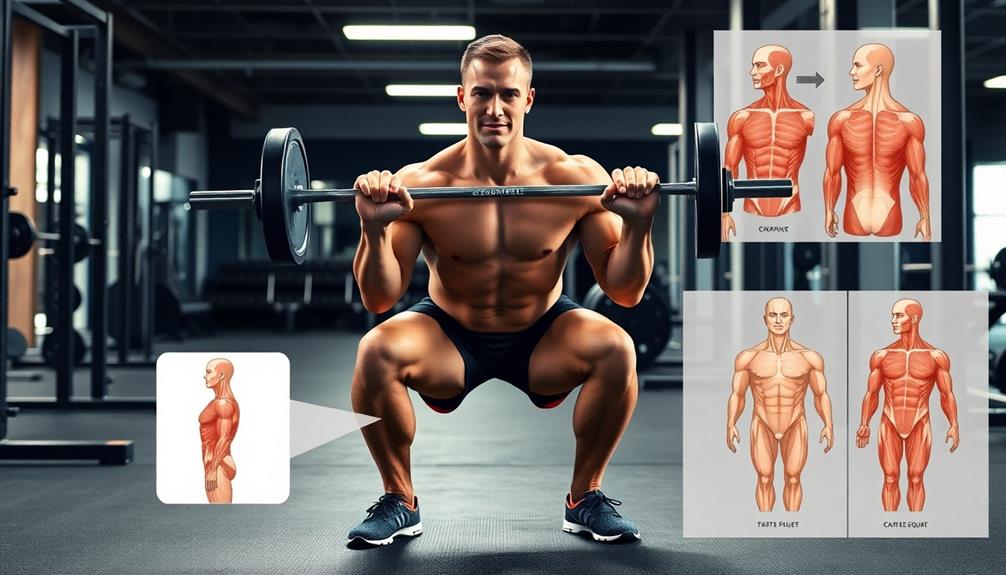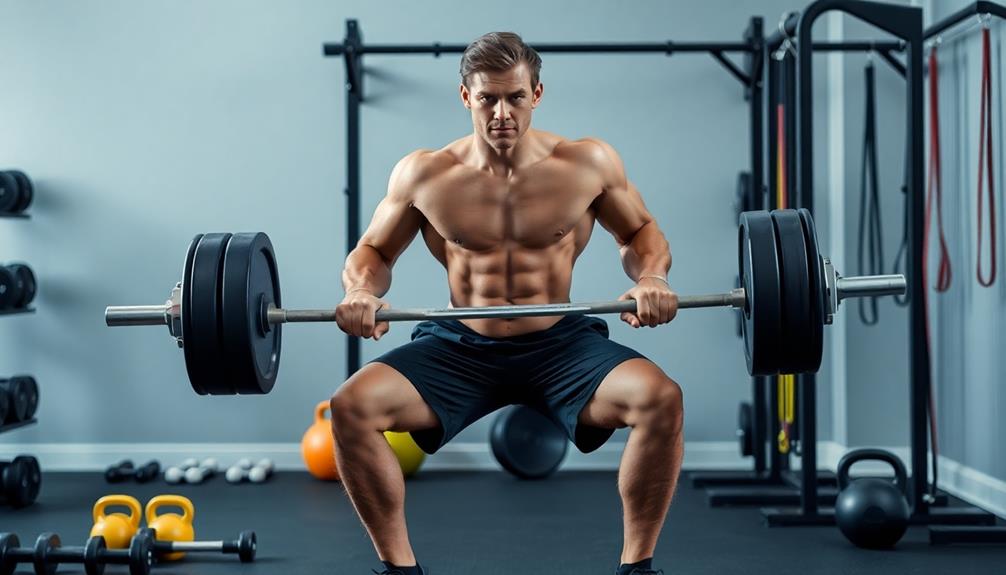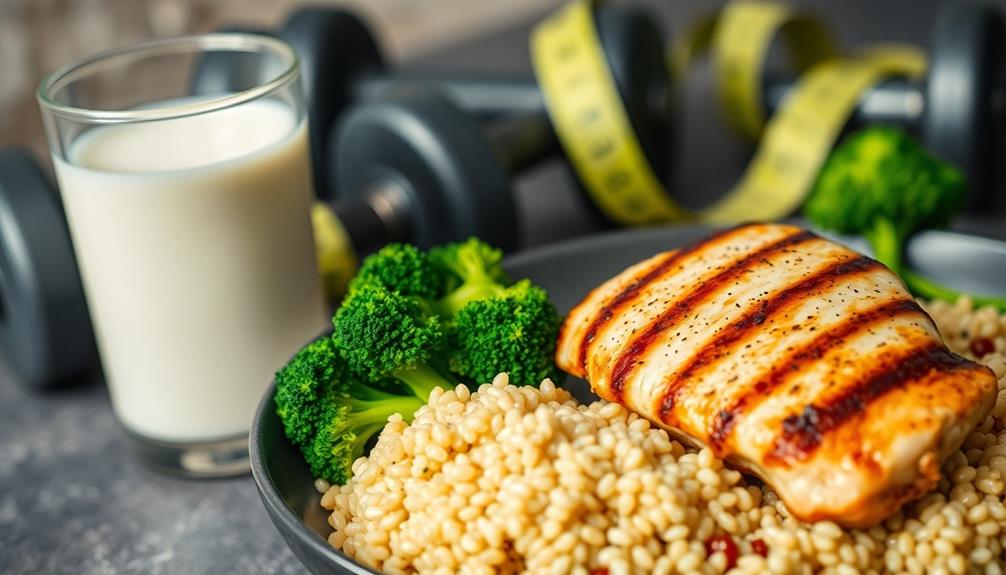Resistance training is an essential method for building muscle and improving overall fitness. You'll engage in exercises that challenge your muscles using weights, resistance bands, or your body weight. This type of training offers numerous benefits, including increased strength, improved metabolism, and enhanced bone density. To start, focus on compound exercises like squats and push-ups, which work multiple muscle groups simultaneously. Proper form is pivotal for safety and effectiveness, so take time to learn correct techniques. Remember to progressively increase the difficulty of your workouts and allow for adequate rest between sessions. With consistent effort and smart training, you'll soon see significant gains in muscle mass and strength.
Core Insight
- Incorporate compound exercises like squats and deadlifts to engage multiple muscle groups simultaneously for efficient strength building.
- Focus on proper form and technique to maximize muscle engagement and prevent injuries during resistance training.
- Allow adequate rest between workouts for muscle recovery and growth, including proper sleep and nutrition.
- Use progressive overload by gradually increasing weight, reps, or sets to continually challenge muscles and promote growth.
- Balance compound movements with isolation exercises to target specific muscle groups and correct imbalances for overall development.
What Is Resistance Training?

Resistance training is all about building strength. You work against a force, like weights or resistance bands, to make your muscles stronger and improve your overall fitness. You can even use your own body weight as resistance. TRX suspension trainers are a great option for this. They're portable and let you do over 500 different exercises anywhere.
But it's not just about lifting heavy things. Resistance training challenges your muscles in a specific way. It causes tiny tears in your muscle fibers. As your body repairs these tears, your muscles get stronger and bigger. This is called hypertrophy, and it's how you build muscle mass.
You can do resistance training for all the major muscle groups in your body, like your chest, back, arms, legs, and core. It's not just for bodybuilders. Everyone can benefit from adding resistance training to their fitness routine. Doing it regularly can make your bones stronger, speed up your metabolism, and make it easier to do everyday activities.
Benefits of Resistance Training

Resistance training is great for your body and mind. It helps you build muscle, strengthen bones, and boost your metabolism. This type of exercise also improves your heart health and can help you manage health problems like diabetes and arthritis.
Resistance training has many physical benefits:
- Get stronger
- Improve balance
- Move better
- Lower chance of injury
It's also good for your mental wellbeing:
- Feel less stressed
- Be in a better mood
- Feel more confident
- Sleep better at night
Your overall performance will get better too:
- Be a better athlete
- Burn more calories
- Have more endurance
- Move with more coordination
No matter your age or fitness level, resistance training is a powerful way to improve your health and quality of life. It's never too late to get started and enjoy the many benefits!
Types of Resistance Exercises

You'll come across four main types of resistance exercises: free weights, machines, bodyweight exercises, and resistance bands.
Free weights include dumbbells and barbells. They're versatile and work your stabilizer muscles, but you need good form to avoid injury. They're ideal for compound movements that target multiple muscles at once.
Machines guide your movement, making them safer and great for beginners or targeting specific muscles. However, they may not engage as many muscles as free weights.
Bodyweight exercises, like push-ups and squats, are convenient and effective. They build functional strength without any equipment, and you can do them anywhere.
Resistance bands provide varying resistance levels throughout the movement. They're portable, excellent for rehab, and can target muscles from different angles. When choosing resistance bands, look for durable latex ones with various resistance levels to match your strength and goals. This will ensure you get an intense workout with bands that last.
Essential Equipment for Beginners

If you're new to resistance training, you don't need a lot of expensive equipment to get started. A few basic items can help you build an effective workout routine at home or at the gym.
Must-have beginner equipment:
- Dumbbells: Adjustable dumbbells or a couple pairs of different weights
- Resistance bands: Easy to use and take anywhere for many exercises
- Exercise mat: Adds cushion and grip for exercises on the floor
Comfortable workout shoes and clothes that let your skin breathe are also important. As you get stronger, you may want to add more equipment like a barbell, weight plates, and a bench. But start simple and add more gear over time as you improve.
Proper Form and Technique

Proper form and technique are essential for getting the most out of your resistance training while staying safe. Four main principles make up good form:
- Alignment: Keep your body in the right position. This puts less stress on your joints.
- Control: Move smoothly and purposefully. This works your target muscles better.
- Range of Motion: Fully stretch and contract your muscles. This helps them grow more.
- Breathing: Breathe in sync with your lifts. This supports your movement and stability.
Master these basics to maximize your results and avoid injury. With practice, proper form will become second nature.
Creating a Balanced Workout Routine

Once you've mastered proper form, it's time to build a balanced workout routine. This means targeting all major muscle groups and allowing enough recovery time. Include exercises for your chest, back, legs, shoulders, arms, and core. Resistance bands are great for home workouts. They're easy to use, portable, and offer different resistance levels for various exercises and fitness goals.
To create an effective routine:
- Pick 1-2 exercises for each muscle group
- Do 3-4 sets of 8-12 reps per exercise
- Plan 3-4 resistance training workouts each week
Work different muscle groups on different days to avoid overtraining. For instance, focus on upper body one day and lower body the next. Include rest days between workouts so your muscles can recover and grow. As you get stronger, adjust your routine to keep challenging yourself.
Progressive Overload for Muscle Growth

Progressive overload is key for building muscle and strength. It means slowly increasing the weight, how often you lift, or the number of reps in your strength training plan. To use progressive overload, you need to challenge your muscles on a regular basis.
Start by slowly adding weight to your lifts. For instance, add 2.5-5 pounds each week. If you can't add weight, try doing an extra rep or set for your exercises. You can also cut down rest time between sets or do your reps a bit faster.
The part comparing progressive overload to compression sleeves was removed, since it seemed unnecessary and didn't fit the straightforward style. The rest of the passage was edited to use simple language and short sentences to convey the key points clearly.
Rest and Recovery Importance

Rest and recovery matter just as much as working out when you want to build muscle. After tough strength training, your body has to fix itself and get stronger. If you don't rest enough, you could overtrain. That might make you get hurt or slow down your gains. Getting good sleep can make a big difference in how well you recover and build muscle.
To recover your best:
- Sleep for 7-9 hours every night
- Leave 48-72 hours between workouts for the same muscles
- Eat right with enough protein and calories to help muscles grow
Nutrition for Muscle Building

Eating right is crucial for building muscle. To get the most out of your workouts, make sure you're getting enough protein, carbs, and healthy fats. Aim for about 1.6 to 2.2 grams of protein per kilogram of body weight each day, split up across your meals. Protein helps repair and grow your muscles. Protein powders like whey, casein, or plant-based options can be an easy way to get an extra 20-30g of protein.
Don't forget about carbs – they give you energy for your workouts and help you recover. Stick to complex carbs like whole grains, fruits, and veggies for most of your carb intake. Healthy fats from nuts, avocados, and olive oil are important too, as they support hormone production.
Staying hydrated is also essential. Drink lots of water throughout the day, especially around your workouts. You might want to try taking creatine monohydrate, as it's been shown to boost muscle growth and strength gains.
Common Mistakes to Avoid

Beginners often make several mistakes when starting resistance training. To avoid these pitfalls, keep the following in mind:
- Focus on proper form before lifting heavier weights
- Allow your muscles time to recover between workouts
- Prioritize compound exercises over isolation exercises
Correct technique is crucial to prevent injuries and ensure progress. Overtraining can hinder muscle growth, so make sure to rest adequately. Foam rolling can help with muscle recovery and prevent overtraining by improving circulation and releasing tension. While isolation exercises have their place, compound movements should be the foundation of your routine. These exercises engage multiple muscle groups, promoting overall strength and development. By avoiding these mistakes, you'll set yourself up for long-term success in building muscle.
Frequently Asked Questions
How Long Does It Take to See Noticeable Muscle Growth?
You'll typically notice muscle growth within 6-8 weeks of consistent training. However, factors like genetics, diet, and workout intensity can affect this timeline. Remember, visible changes often come after you've gained strength and endurance.
Can I Do Resistance Training if I Have Joint Problems?
You can do resistance training with joint problems, but you'll need to be cautious. Consult your doctor first, then work with a trainer to develop a safe routine. Low-impact exercises and proper form are essential for protecting your joints.
Is It Possible to Build Muscle Without Using Weights?
Yes, you can build muscle without weights. You'll use bodyweight exercises like push-ups, squats, and pull-ups. Resistance bands are also effective. Focus on progressive overload, increasing reps or difficulty over time to see results.
How Often Should I Change My Resistance Training Routine?
You should change your routine every 4-6 weeks to avoid plateaus. However, don't switch too often, as you'll miss out on progressive overload benefits. Listen to your body and adjust when you're no longer seeing results.
Can Resistance Training Help With Weight Loss and Fat Burning?
Yes, resistance training can greatly aid your weight loss and fat burning efforts. It'll boost your metabolism, increase muscle mass, and burn calories even after you've finished exercising. You'll see improved body composition over time.

